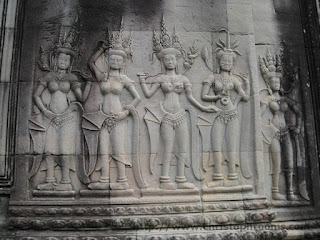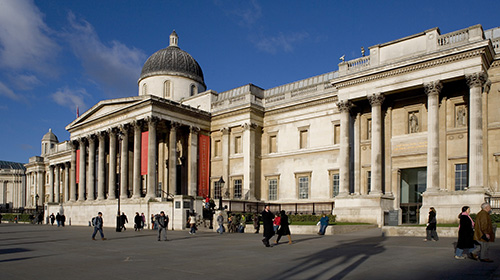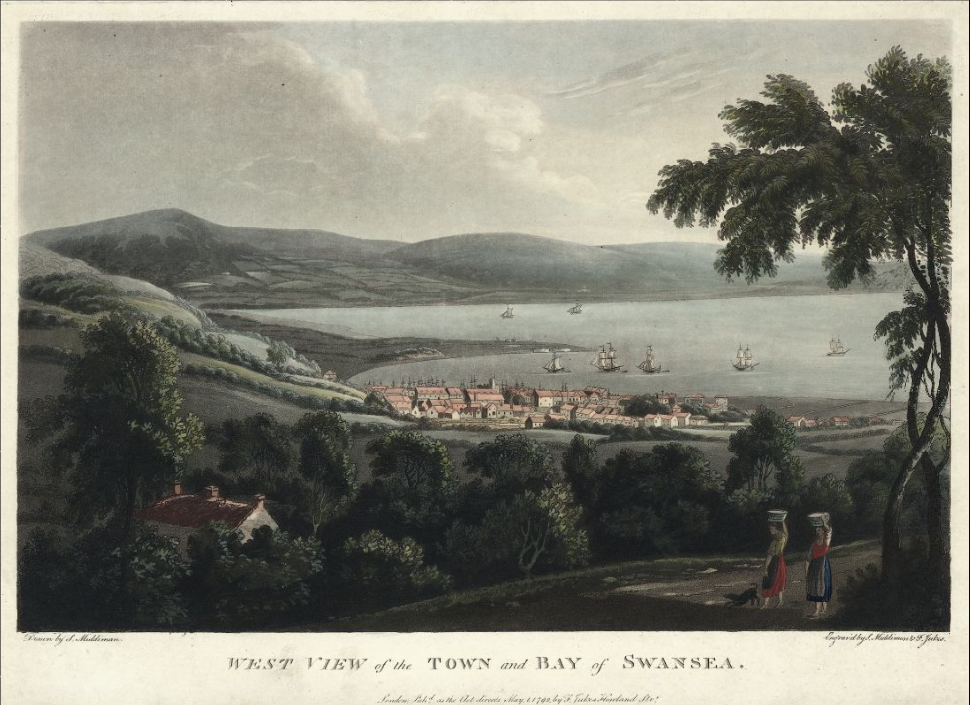aerial view of Angkor Wat
totally surrounded by wall
When the Khmer Empire came to power, Hinduism became the official religion. Angkor in Northern Cambodia was the capital of the Khmer Empire and thrived from the C9th on, marking the apex of its architecture. Angkor stretched over 400km², home to a number of temples: Angkor Wat, Angkor Thom, Bayon Temple and Ta Prohm. Angkor Wat was a temple complex with 1000+ buildings, one of the great cultural wonders anywhere.
One of the 5 central towers
Because the temple complex was built in the Khmer Empire capital, all of the original religious motifs were derived from Hinduism, and were dedicated to the gods Shiva, Brahma and Vishnu. Note that Angkor Wat faced west, dedicated to the Hindu god Vishnu.
The 5 central towers of Angkor Wat symbolised the 5 peaks of Mt Meru, which the Hindu faith saw as the dwelling place of the gods. The 15’ high walls signified the surrounding mountain ranges and the moat represented the sea, both structures protecting the complex. A 188-metre bridge allowed access to the site, then visitors reached the temple by passing through 3 galleries, each separated by a paved path.
To further emphasise the Hindu symbolism, the temple walls were lined with c2,000 square ms of beautiful bas-relief sculpture carved into the sandstone. Plus there were extensively carved lintels, friezes and pediments, 2,000 celestial dancers entertaining the gods on the walls, and depictions of the Angkorian king and his court. Most sculptures depicted the Hindu epics Ramayana and Mahabharata.
Examine the architecture. A wide rectangular moat surrounded the complex, and just inside the moat an outer wall defined an area c1,500 ms E-W, and 1,300 ms N-S. Some archaeologists suggested that 90% of this area was originally surrounded by a city around the formal temple precinct, including the royal palace, all built of wood. Only the temple’s interior structures, built in sandstone and laterite
clay, remain today.
From the western gateway of the outer wall, a long causeway led to the main temple precinct. Two small stone buildings, called libraries/ shrines, flanked the causeway near the midpoint.
The temple itself consisted of the primary elements of Khmer architecture: 1] pyramids and 2] concentric galleries. Each pyramid took the form of 3 stepped terraces, with the steps bordered on all sides by covered galleries. At each level gateways in the galleries indicated the pathway to the central shrine, and towers punctuated the corners. The pyramid culminated in 5 towers, marking the central shrine.
The whole complex symbolised the Hindu beliefs enshrined within, a microcosm of the Hindu universe. The moat represented the mythical oceans surrounding the earth and the succession of concentric galleries represent the mountain ranges that surround Mt Meru. The towers represented the mountain’s peaks, and the experience of the ascent to the central shrine seemed like climbing a real mountain. Dedication to the Hindu god Vishnu only ended in the C13th.
After the Cham people sacked Angkor in 1177, King Jayavarman VII (reigned 1181–c1220) decided that the Hindu gods had deserted him. When he built a new capital nearby, Angkor Thom, he dedicated it to Buddhism. Thereafter Angkor Wat became a Buddhist shrine, and many of its carvings and statues of Hindu deities were replaced by Buddhist art. Note that Buddhist tolerance for Hinduism meant that the iconography of its great reliefs was not totally replaced; some of the intricate sandstone bas-relief sculptures were still showing Khmer artistry.
In the decades after Suryavarman II’s death and his cousin’s dismal reign, King Jayavarman VII converted many of the temples to Buddhist use. The temples at Angkor were often depicted as the ruins of a failed society, but actually the rise of Theravada Buddhism led to the construction of wooden temples that didn’t survive. Angkor Wat had represented the best building tradition over 5 centuries. In the early C15th Angkor DID come to a standstill, yet Buddhist monks maintained Angkor Wat for pilgrims.
One of the first modern Western visitors was a Portuguese friar who visited in 1586. Angkor Wat was later “re-discovered” by the French naturalist Henri Mouhot in the 1840s. Mouhot’s notes, published in 1863, aroused Western interest in Angkor and the Ecole Francaise d’ Extreme-Orient began leading conservation efforts.
The temple itself consisted of the primary elements of Khmer architecture: 1] pyramids and 2] concentric galleries. Each pyramid took the form of 3 stepped terraces, with the steps bordered on all sides by covered galleries. At each level gateways in the galleries indicated the pathway to the central shrine, and towers punctuated the corners. The pyramid culminated in 5 towers, marking the central shrine.
The whole complex symbolised the Hindu beliefs enshrined within, a microcosm of the Hindu universe. The moat represented the mythical oceans surrounding the earth and the succession of concentric galleries represent the mountain ranges that surround Mt Meru. The towers represented the mountain’s peaks, and the experience of the ascent to the central shrine seemed like climbing a real mountain. Dedication to the Hindu god Vishnu only ended in the C13th.
After the Cham people sacked Angkor in 1177, King Jayavarman VII (reigned 1181–c1220) decided that the Hindu gods had deserted him. When he built a new capital nearby, Angkor Thom, he dedicated it to Buddhism. Thereafter Angkor Wat became a Buddhist shrine, and many of its carvings and statues of Hindu deities were replaced by Buddhist art. Note that Buddhist tolerance for Hinduism meant that the iconography of its great reliefs was not totally replaced; some of the intricate sandstone bas-relief sculptures were still showing Khmer artistry.
In the decades after Suryavarman II’s death and his cousin’s dismal reign, King Jayavarman VII converted many of the temples to Buddhist use. The temples at Angkor were often depicted as the ruins of a failed society, but actually the rise of Theravada Buddhism led to the construction of wooden temples that didn’t survive. Angkor Wat had represented the best building tradition over 5 centuries. In the early C15th Angkor DID come to a standstill, yet Buddhist monks maintained Angkor Wat for pilgrims.
One of the first modern Western visitors was a Portuguese friar who visited in 1586. Angkor Wat was later “re-discovered” by the French naturalist Henri Mouhot in the 1840s. Mouhot’s notes, published in 1863, aroused Western interest in Angkor and the Ecole Francaise d’ Extreme-Orient began leading conservation efforts.
The Cambodian flag







.jpg)






















































22 comments:
Very fascinating historical details. It is always interesting to read about these civilisations -- the way they ruled, their architecture, their social composition, etc.
This is the part of world I wish to explore.
Pradeep
the more we know about an old civilisation, the more we learn about the important influences - local wars, national religions, weather and altitude, history of the ruling dynasty etc. For example would the 5 central towers have been designed thus, had the commission came for a French Catholic monastery? Never!
I love the reading and the exploring :)
roentare
Great idea! I know a great deal about European, Indian, Asian Russian and Middle Eastern architecture, all of it telling the history, culture and religion of the countries concerned. But I knew sod all about South East Asia, and had to ask a lot of questions of traveller friends for this post.
While relying on other peoples' knowledge makes me anxious, expanding my knowledge base makes me excited.
Helen I am sending you this article called is Angkor Wat Worth Visiting?
https://wanderonwards.co/turn-down-for-wat-welcome-to-angkor-wat-cambodia/#:~:text=That%20being%20said%2C%20Angkor%20Wat,Angkor%20Wat%20is%20worth%20visiting
After all the temples that I have ever seen in Asia, the Angkor Temples are BY FAR my favorite and most memorable experience… yet. Even though Cambodia isn’t completely a tourist trap yet… yet. These local folks have already gotten ahead of their competition by positioning themselves to earn a ton of money off of tourists with nothing better to do with their dollar… such as myself.
That being said, Angkor Wat is the only archeological complex of its kind and that makes it pretty spectacular. It sets itself apart from a lot of the other temples around Cambodia and further afield in Southeast Asia, so by that distinction alone, Angkor Wat is worth visiting. After all, it is one of THE things to do in Cambodia for a reason!
If you buy direct from official Angkor Wat sites or from the ticket office itself, the prices are $37 for the one-day pass and $62 for the three-day
I wonder how many tourists appreciate the history of this complex and how many just want to tick it off their list of things to see. Whatever the motivation, the ticket prices contribute to the continued upkeep and preservation.
Wander Onwards
I read your article and want to thank you for the practical advice. I might know a great deal about architecture and decorative arts, but what makes an experience memorable (or otherwise) are prices, crowding, temperatures, cleanliness, quality of the guides, ability to take photos etc.
jabblog
That is exactly what my spouse says :)
Ticking a tourist site off a list might be a serious consideration (for me at least) in London, Paris or Vienna because I am there often. But going to Cambodia would require careful planning, lots of reading and pre-booking of everything. It would probably be a once-in-a-lifetime experience.
Cambodia is famous for two things: the spectacular architecture of the Angkor complex, and the Khmer Rouge cruel, bloody regime. As far as I know, it's a poor country, not very touristy.
I became aware of Cambodia in the years 1975 - 1979, the period of the Khmer Rouge regime, until the Vietnamese troops defeated it.
Another Hells post, which I read with interest.
I imagine Angkor Wat live will be the experience of a lifetime for anyone who makes the trip. I didn't expect it to be so big.
I was also impressed by some details like it's 1,000+ temples, 2,000 sky dancers..
Thank you so much Hels for this trip!
The photos made me go WOW, talk about impressive, I know bugga all about Cambodia but of course I have heard of the Khmer Rouge. So another wonderful and informative post.
This is a place I have always wanted to visit.
DUTA
sadly true...the Khmer Rouge was murderous, to its own citizens. And since they weren't members of any religious group, you would have expected Cambodia's religious sites would have been totally destroyed. Yet Angkor Wat survived, intact except for some war damage from a distance. Perhaps Khmer Rouge wanted to get rid of Western, modern influences and so were careful to protect the nation's historical past.
Tourism in the last 25 years has rocketed in Cambodia. Somewhere between 2-6 million visitors arrive each year.
Katerina
I hope we all get the chance to visit Cambodia, a place that was not on most of our bucket list destinations back in the day. If your time on the ground is going to be limited, do lots of reading and planning first.
Jo-Anne
The Khmer Rouge had taken power in the country after the Cambodian Civil War that ended in 1975. The Khmer Rouge's genocide was a horrendous massacre that killed up to 3 million of their own citizens in the late 1970s.
So although the Khmer Rouge atrocities were ages ago, the legacy of the genocide to some extent still influences the nation's thinking now.
Cherry Pie
I suppose the very long Covid lockdowns, the huge costs of airfares now and the constant wars make people think carefully about future travel. But if you can possibly make the trip happen, I think you will have a great time in Cambodia.
Enjoyed reading and I continue to learn.
Magic building indeed Hels.
Margaret
at 25 I thought I knew everything there was to know; young people are so self assured about their learning that they sound almost arrogant. Now I am far more modest about learning, and am very grateful to read other peoples' research and experiences.
If you do continue to learn about Angkor Wat, or any of our other topics, I would be very pleased if you shared the reading/photos on line.
I would love to visit Ankor Wat. Thanks for this interesting post. And I agree with your comment above mine. There is so much out there to learn about, and so much of it is fascinating. Have a great rest of your weekend.
I'd love to visit Ankor Wat but I tend to avoid crowds. In Europe it's easy - I always travel outside of school holidays - but I imagine weather is a great driver of tourist seasons in SE Asia. I enjoyed the detailed history, thank you!
Mandy
I always travelled somewhere in UK, Europe, the Middle East, India or North America each northern summer... until the first Covid lockdown. Since Jan 2019 I haven't been anywhere.
But my beloved loved going to Japan, China and SE Asia, and now plans to take me too :)
Erika
I hope you do get to tour areas like Angkor Wat that you have never visited before. We all need to broaden our travel horizons!
Post a Comment